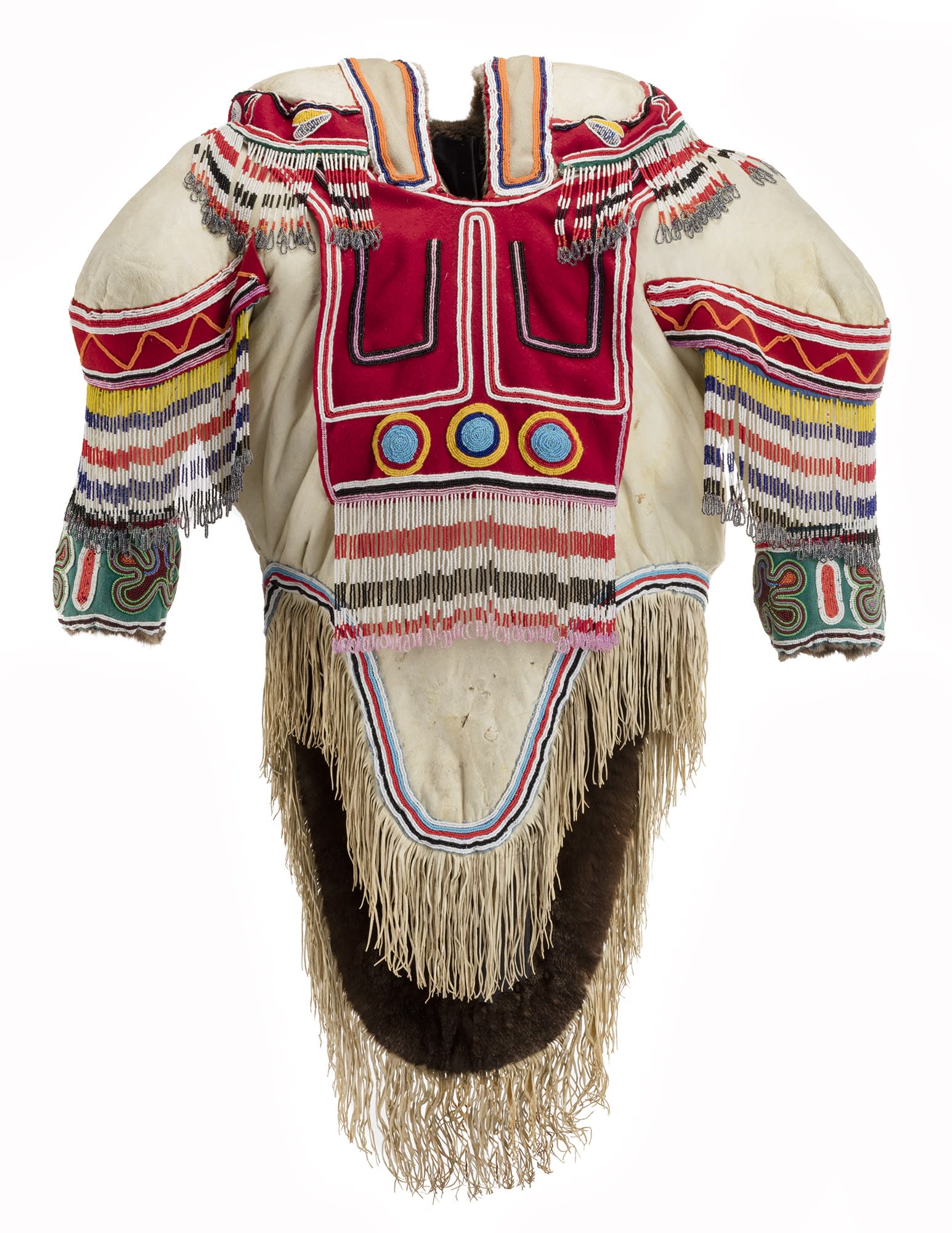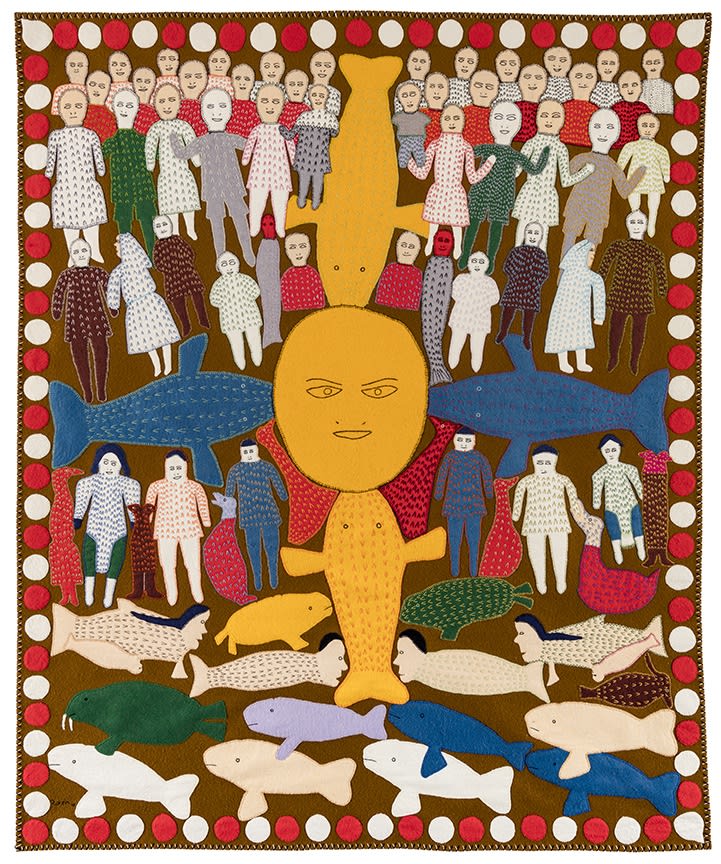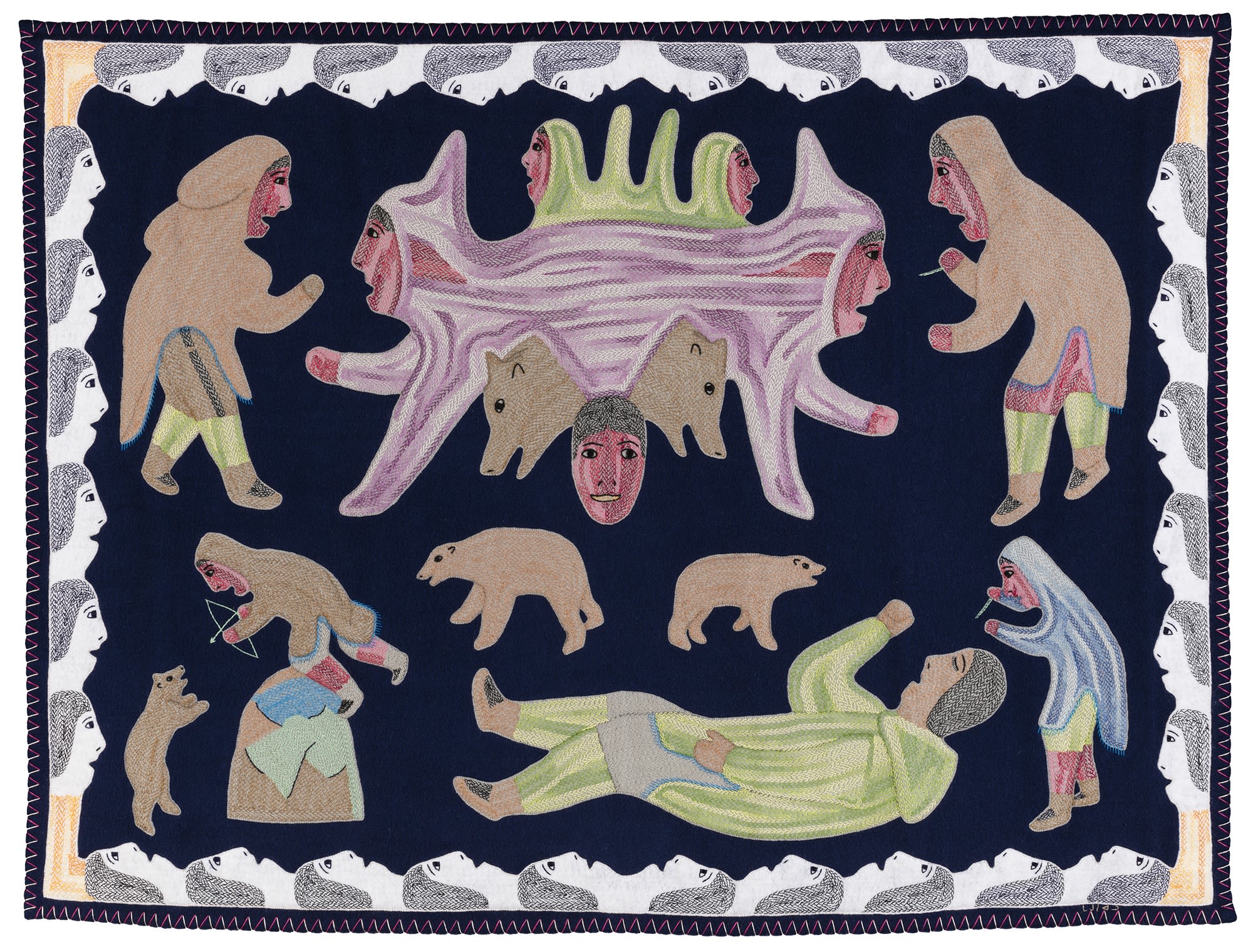In previous writings we have touched on Inuit textile work and its place within the history of the Canadian North, both as a lifesaving skill and its beauty as an artistic practice. Sewing has long been an integral part of an Inuit woman’s ability to protect and provide for her family and those around her. What was once an ingrained aspect of life on the land has been transformed into a medium celebrated as an artform in its own right. Perhaps more than in any other region in Canada’s Arctic, the various sewing arts have thrived and evolved in the Kivalliq (Keewatin) Region west of Hudson Bay.

Lot 20
UNIDENTIFIED ARTIST, ARVIAT (ESKIMO POINT) or KANGIQLINIQ (RANKIN INLET)
Beaded Caribou Skin Amautiq, c. 1980s
ESTIMATE: $10,000 — $15,000
Garments unique to Inuit, amautiit have served as a longstanding symbol of northern motherhood and female labour. A traditional caribou skin amautiq is a long, labour-intensive undertaking, with the preparation of the skins through tanning, scraping and softening being a sizeable portion of the work before the amautiq’s construction can even begin. Once ready, the skins can be cut down into individual pieces, customized not only to the eventual wearer, but to the needs of a northern climate. The longer “tail” coming down the back of the amautiq provides an insulated barrier to the snow when sat upon, for example. The recognizable hood and back pouch allow infants to be safe and warm from the elements next to their mother’s body, but the extra room allows for some movement in the amauti as well, making things like breastfeeding a less frosty experience for all involved. Once constructed, the garment becomes a practical and functional canvas for a maker’s designs. Older examples were trimmed with fur and ivory toggles, and later ones with glass beads and coloured fabric as trading brought more materials north. Lot 20 is a tuilik style of amautiq, which is common in the Kivalliq region of Nunavut. It features larger, broader shoulders than do other styles of amautiq, creating perfect shapes from which to drape multi-coloured rows of beaded fringe.

Lot 123
JESSIE OONARK, O.C., R.C.A. (1906-1985) QAMANI'TUAQ (BAKER LAKE)
Untitled Work on Cloth, 1974
ESTIMATE: $30,000 — $50,000
As times shifted in the North, makers shifted along with them and expanded their skills to create more decorative items for an outside market. In Qamani’tuaq (Baker Lake), a community now synonymous with the art form, the first rise in popularity for works on cloth began in the early 1970s. Working out of their own homes and then bringing their work to an offshoot of the community’s printshop, the Craft Shop, the first generation of textile artists used Duffle, stroud, felt, and thread to bring both cultural and personal stories to life. With her careful hand and almost unbridled imagination, Jessie Oonark’s creative vision stands out; her depictions of traditional life and mythical forms have become iconic, be they on paper or cloth. Lot 123, a delightful and unusually long, horizontal image, depicts the artist and her family in a newly purchased canoe, beaming with pride. With an almost hypnotic repetition of pattern and form, the narrative aspect of the work is highlighted with punches of contrasting thread and beautifully stitched fringe on coat hems. The narrative is, however, very much infused with the symbolic and supernatural.

Lot 21
MARION TUU'LUQ (1910-2002) QAMANI'TUAQ (BAKER LAKE)
Prayer Meeting, 1989
ESTIMATE: $60,000 — $90,000
A contemporary and close friend of Oonark, Marion Tuu’luq had a staggering output of sewn works. Many of her pieces have specific narratives or scenes, and her figures have a charming individuality to them. Tuu’luq was never one to leave a sizable portion of a work empty, and her works are packed with figures, action, and detail. Prayer Meeting is a joyous co-mingling of people and creatures, each with embroidered details and colours. Humans, animals, and hybrid creatures are all densely packed into the scene, popping against the brown background. This work on cloth was exhibited at the landmark solo exhibition of the artist’s work at the National Gallery of Canada in 2002. Curator Marie Bouchard spoke to the deeper themes of the work in the catalogue: “Produced when Tuu’luq was seventy-nine years old, this work may have been conceived after a bit of covert soul-searching into her own beliefs about the central importance of religion, in both forms [Christian and traditional], and the relationship between them in her life.” This is all the more poignant since we now know that this was the very last textile work Tuu’luq would create.
1. Marie Bouchard, “Negotiating a Third Space: The Works on Cloth of Marion Tuu’luq” in Marion Tuu’luq, (Ottawa: NGC, 2002:17-45), p. 41.

Lot 62
VICTORIA MAMNGUQSUALUK (1930-2016) QAMANI'TUAQ (BAKER LAKE)
Scenes from the Legend of Kiviuq, 2001
ESTIMATE: $8,000 — $12,000
In the hands of Mamnguqsualuk (one of Oonark’s talented artist-children), sewn and embroidered textiles provide a way to tell tales, to transmit culture and history to a new generation, and to providing visual aids to oral storytelling. Mamnguqsualuk began drawing and sewing by 1970, but important was also a member of Qamani’tuaq’s textile renaissance in the 1990s. She is notable for being a visual storyteller in a variety of media and is most famous for her almost obsessive interest in Kiviuq, the immortal, legendary wandering hero of the North. The Kiviuq story cycle continues to be passed down through oral tradition throughout the Arctic. As is typical, here Mamnguqsualuk puts forth a narrative that is not strictly linear; characters make repeat appearances in the somewhat bumpy chain of events, with the portrayal including some details and eliminating others. The felt appliqué characters are festooned with gorgeous, almost painterly embroidery; long chains of feather stitches made from variegated thread give the figures the subtle illusion of texture and depth.

Lot 24
JANET KIGUSIUQ (1926-2005) QAMANI'TUAQ (BAKER LAKE)
People, Bear, and Dogs, 1994
ESTIMATE: $8,000 — $12,000
Janet Kigusiuq (also one of Oonark’s daughters) was an accomplished artist in several media with a style that evolved noticeably over the decades. While usually narrative in some form, her later works increasingly favoured large blocks of bold colour, with fewer, larger human and animal figures. In Lot 24 we are treated to Kigusiuq’s highly distinctive figural and compositional style. Presented on quite a grand scale, the central character here could well be life-sized as he smiles out at the viewer. He is this work’s clearest sign of Kigusiuq’s tendency to skew perspective, with the other occupants of this image almost dwarfed by comparison. As with all storytellers, it is the personal flourish that is added that makes the story their own: is Kigusiuq’s central figure being followed by the others in the scene, or are they simply viewing him as we do? Likewise, are the two dogs at lower right having the same conversation as us?
